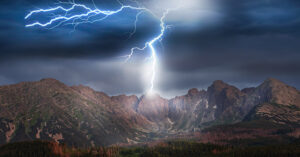Education
Climate Change Strikes: Lightning Patterns Change With Global Warming

New research has shown climate change could alter lightning patterns across Europe.
- More frequent storms with more energy, but locally less lightning mainly due to less cloud ice and frozen particles in storm clouds, with warming
- More lightning at high altitude – including over the Alps
- Less lightning on lower terrain in central Europe and over the sea– subject to circulation changes, which are less certain
The researchers found these changes could lead to an increased risk of wildfires over the mountains and in Northern Europe but as the authors explain it’s not all bad news.

Source – Newcastle university
While more frequent lightning strikes over mountains and in Northern Europe might trigger more wildfires in higher level forests, we are going to see relatively fewer lightning hazards over more populated areas of Central Europe.
New risks from increases in lightning
Study lead author, Dr Abdullah Kahraman, Senior Researcher in Severe Weather and Climate Change, School of Engineering, Newcastle University and Visiting Scientist – Understanding Regional Climate Change (URCC), Met Office Hadley Centre, said: “While more frequent lightning strikes over mountains and in Northern Europe might trigger more wildfires in higher level forests, we are going to see relatively fewer lightning hazards over more populated areas of Central Europe.”
The researchers say these findings highlight the need to re-evaluate lightning risk to wildfires, properties, and human life across Europe.
Study co-author, Professor Hayley Fowler, Professor of Climate Change Impacts, Newcastle University School of Engineering, added: “This is just more bad news for critical national infrastructure in northern Europe, after the damning report ‘Readiness for storms ahead? Critical national infrastructure in an age of climate change’ by the Joint Committee on the National Security Strategy last week. Our paper has highlighted new risks from increases in lightning, previously unknown, which will require increased investment in climate adaptation measures. Further analysis is needed of the potential impact of these increases in lightning on energy and other critical infrastructure systems to enable policies and measures to be produced that are locally- and sector-relevant for adaptation planning.”
This is from the latest Met Office climate simulations with the highest local details in meteorological and topographical features down to 2km, which, unlike previous studies, allows individual thunderstorms and their crucial processes resulting in lightning to be simulated across Europe. This is one possible realisation of an unmitigated future climate (RCP8.5 scenario), and uncertainties exist especially in terms of circulation changes.
Professor Lizzie Kendon, Met Office Science Fellow and co-author on the paper, said that “These new very high-resolution climate projections, which have a resolution on a par with weather forecast models, are providing new insights into future changes in convective storms and their associated hazards – such as heavy downpours, lightning, hail and wind gusts. Changes in lightning in this study are in contrast with previous studies. This shows us that representing the fundamental physical processes within storms themselves is important and can lead to future changes that are even of the opposite sign
Source – NewCastle University
-

 Auto2 years ago
Auto2 years agoHonda Marine Debuts All-New BF350 Outboard Company’s First V8 Motor Available Commercially, Flagship Model Offers Premium Power and Unparalleled Performance for Extraordinary Boating Experiences
-

 Auto2 years ago
Auto2 years agoNew Features Further Increase Desirability Of Bentayga Range
-

 Technology2 years ago
Technology2 years agoOracle Partners with TELMEX-Triara to Become the Only Hyperscaler with Two Cloud Regions in Mexico
-

 Auto2 years ago
Auto2 years agoHonda and Acura Electric Vehicles Will Have Access to Largest EV Charging Networks in North America Aided by New Agreements with EVgo and Electrify America
-

 Lifestyle2 years ago
Lifestyle2 years ago2023 Nike World Basketball Festival Brings the Best of Basketball Style, Culture and Community














